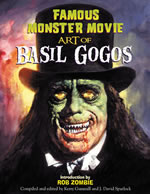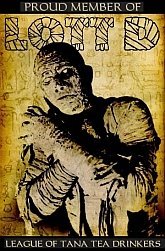 Zombos Says: Very Good
Zombos Says: Very Good
Suppose you left your town and home many years ago, and drifted along here and there, never putting down roots. Suppose you are homeless, friendless, and suffer from a fragmented memory, whose shards of clarity are confusing and terrifying. What is it you can't remember, but can't seem to fully forget? Portrait of a man in crisis: George Walker.
In indie director and co-writer (along with Brian Majeska) Lance Weiler's Head Trauma, George Walker returns to his deceased grandmother's house and soon goes head to head with those shards of memory; and a mysterious and ominous Snorkel Parka dressed individual who just may be a maniacal killer.
But why does he go after George? Is it because George's return to his grandmother's abandoned and condemned house, filled with dark corners, squatter debris, and a really creepy attic—
"This review won't fly, you know," said Zombos, peering over my shoulder.
"What?" I said.
 "Didn't you listen to the director's commentary? He mentions this film came from his own experience with head trauma after a serious auto accident. He goes on to mention how he worked through Kubler-Ross' stages of grief and—"
"Didn't you listen to the director's commentary? He mentions this film came from his own experience with head trauma after a serious auto accident. He goes on to mention how he worked through Kubler-Ross' stages of grief and—"
"You mean her five stages of receiving really bad news. Not sure how "grief" got in there over the years, but the original sense was for catastrophic news; which can lead to grief, I suppose."
"Whatever," said Zombos. "The point I am trying to make is that you can't review the story without realizing the director's subtexts of denial, anger, bargaining, depression, and acceptance that pace the film into a character study of self-awareness."
"You mean how George was in a state of denial for many years before he returns to his deceased grandmother's house?"
"Right. In the opening scene, we see George sleeping out in the open, and awakened by a bad dream of an auto accident. He is making the trek back to his grandmother's house."
"But what about the anger part?"
 "When he returns home, he has to deal with a neighbor that wants the house demolished so he can buy the property, a massively flooded basement, a ruined relationship with old-flame Mary, the presence of a mysterious person dressed in the parka, and trying to keep the house from being torn down."
"When he returns home, he has to deal with a neighbor that wants the house demolished so he can buy the property, a massively flooded basement, a ruined relationship with old-flame Mary, the presence of a mysterious person dressed in the parka, and trying to keep the house from being torn down."
"With all those bad nightmares of his on top of all that, I'd say he has some anger management going on. Okay, what about bargaining?"
Zombos thought for a moment. "He has to bargain with Julian, the young man next door for help in fixing the house up. He also bargains that he can persuade the town's building inspector to not have the building torn down. He tries to bargain with Mary."
"The ex-girlfriend he meets in the local hardware store while looking for a water pump?"
"Right. Apparently they had something going on between them before he left town. His showing up at her door, with pie no less, at an ungodly hour of the morning is a bargaining ploy."
"And he wants to spend the night with her because he is also scared of being in the house alone," I added. "Everybody thinks the place is haunted anyway. And even Julian is creeped out when he has to go into the attic, or down in the basement alone."
 "Yes, there are nice shock cuts that keep the tension going, along with brooding scenes of the house and its desolate rooms. No splatter gore, or naked screaming nubile woman to distract you from the carefully paced mood," agreed Zombos. "The focus stays on George, his depression over his current state of affairs, and failure to achieve his goals, and his growing realization of something just out of the corner of his eye waiting to poke a finger in it. I daresay his encounter in the basement with the dark hair bobbing up out of the water, presumably attached to a head just out of sight, would unsettle anyone's nerves."
"Yes, there are nice shock cuts that keep the tension going, along with brooding scenes of the house and its desolate rooms. No splatter gore, or naked screaming nubile woman to distract you from the carefully paced mood," agreed Zombos. "The focus stays on George, his depression over his current state of affairs, and failure to achieve his goals, and his growing realization of something just out of the corner of his eye waiting to poke a finger in it. I daresay his encounter in the basement with the dark hair bobbing up out of the water, presumably attached to a head just out of sight, would unsettle anyone's nerves."
"The eerie tooth wrapped in dark hair, found between the floorboards, and the intercut of scenes—and here Weiler keeps you guessing as to whether they are flashbacks, or lucid dreams, or depictions of events in real-time—keep us off balance until the acceptance part of the film."
"The shock cuts of the J-horror girl in the woods, in the house, in the flooded basement are done well. While not very frightening, they still move the story to a point of realization for George and us. Things were not quite what they seemed, and George's head trauma covered up another, deeper trauma." I pushed my chair back from the desk. "Elements in the film trigger George's visions, but also tie his present life to his more secret past life.
 "Those scenes do not need to be very frightening," said Zombos. "They do need to unsettle and confuse George and us, and that's what they do."
"Those scenes do not need to be very frightening," said Zombos. "They do need to unsettle and confuse George and us, and that's what they do."
"The production values for this indie are quite high," I said.
"Right, and the acting is very well done, also. Vince Mola plays George with all the right angst, and Jamil A.C. Mangan does a solid performance as the comic-drawing Julian, reluctantly helping George, and dealing with that creepy abandoned house."
"Speaking of that house," I said, "the extras on the DVD include a segment on filming in the house. It was indeed a creepy place, and I got chills watching the segment last night. They were lucky to find it: it had an effective dark character, and the debris in it was disgustingly real. Quite a demented provenance, to be sure. Cinematography did a skillful job of lighting it all, especially the basement. How they flooded the basement, or made it look like it was completely flooded, is fascinating. I am always amazed at how resourceful indie production crews can be with small budgets, but lots of talent."
"I found the director's commentary very informative," said Zombos. "Lance does a wonderful job of explaining his rationale for the setups, and adds technical information that only an indie director would do. I look forward to his next endeavor."
 "Indeed," I said. "I'm just not sure if I would classify this film as horror, though."
"Indeed," I said. "I'm just not sure if I would classify this film as horror, though."
"Psychological thriller, then. It is simply a very good film, well-scripted and directed, with on-the-money performances and solid cinematography. And production values that are top-notch," added Zombos.
 Every boy when I was growing up wanted a Daisy BB Gun, and every mother I knew worried about us boys shooting our eyes out with it, as so well depicted in the classic film, A Christmas Story.
Every boy when I was growing up wanted a Daisy BB Gun, and every mother I knew worried about us boys shooting our eyes out with it, as so well depicted in the classic film, A Christmas Story.
 In our never-ending quest to bring you the most fun apparel any zombie-lover -- that's you! -- can wear, Chindi spotted this chic t-shirt that reminds us of how much we love to eat fresh at Subway, and how much we love to watch zombies eat fresh, too.
In our never-ending quest to bring you the most fun apparel any zombie-lover -- that's you! -- can wear, Chindi spotted this chic t-shirt that reminds us of how much we love to eat fresh at Subway, and how much we love to watch zombies eat fresh, too.  Zombos Says: Very Good (but weird)
Zombos Says: Very Good (but weird)
 Zombos Says: Very Good
Zombos Says: Very Good "Didn't you listen to the director's commentary? He mentions this film came from his own experience with head trauma after a serious auto accident. He goes on to mention how he worked through Kubler-Ross' stages of grief and—"
"Didn't you listen to the director's commentary? He mentions this film came from his own experience with head trauma after a serious auto accident. He goes on to mention how he worked through Kubler-Ross' stages of grief and—" "When he returns home, he has to deal with a neighbor that wants the house demolished so he can buy the property, a massively flooded basement, a ruined relationship with old-flame Mary, the presence of a mysterious person dressed in the parka, and trying to keep the house from being torn down."
"When he returns home, he has to deal with a neighbor that wants the house demolished so he can buy the property, a massively flooded basement, a ruined relationship with old-flame Mary, the presence of a mysterious person dressed in the parka, and trying to keep the house from being torn down." "Yes, there are nice shock cuts that keep the tension going, along with brooding scenes of the house and its desolate rooms. No splatter gore, or naked screaming nubile woman to distract you from the carefully paced mood," agreed Zombos. "The focus stays on George, his depression over his current state of affairs, and failure to achieve his goals, and his growing realization of something just out of the corner of his eye waiting to poke a finger in it. I daresay his encounter in the basement with the dark hair bobbing up out of the water, presumably attached to a head just out of sight, would unsettle anyone's nerves."
"Yes, there are nice shock cuts that keep the tension going, along with brooding scenes of the house and its desolate rooms. No splatter gore, or naked screaming nubile woman to distract you from the carefully paced mood," agreed Zombos. "The focus stays on George, his depression over his current state of affairs, and failure to achieve his goals, and his growing realization of something just out of the corner of his eye waiting to poke a finger in it. I daresay his encounter in the basement with the dark hair bobbing up out of the water, presumably attached to a head just out of sight, would unsettle anyone's nerves." "Those scenes do not need to be very frightening," said Zombos. "They do need to unsettle and confuse George and us, and that's what they do."
"Those scenes do not need to be very frightening," said Zombos. "They do need to unsettle and confuse George and us, and that's what they do." "Indeed," I said. "I'm just not sure if I would classify this film as horror, though."
"Indeed," I said. "I'm just not sure if I would classify this film as horror, though." So there you stand, scratching your severed head in dismay; what gifts to get that ho-ho-ho-so difficult horrorhead in your family? Why suffer the hordes of zombiefied holiday shoppers, overwhelmed store employees, and bargain bins of the damned when you can sail down the Amazon in shopping comfort while sipping your favorite frothy beverage? To help you with your gift buying, Zombos Closet presents the first annual list of bloody best books any fan of horror cinema would die and come back for, again and again.
So there you stand, scratching your severed head in dismay; what gifts to get that ho-ho-ho-so difficult horrorhead in your family? Why suffer the hordes of zombiefied holiday shoppers, overwhelmed store employees, and bargain bins of the damned when you can sail down the Amazon in shopping comfort while sipping your favorite frothy beverage? To help you with your gift buying, Zombos Closet presents the first annual list of bloody best books any fan of horror cinema would die and come back for, again and again. 

